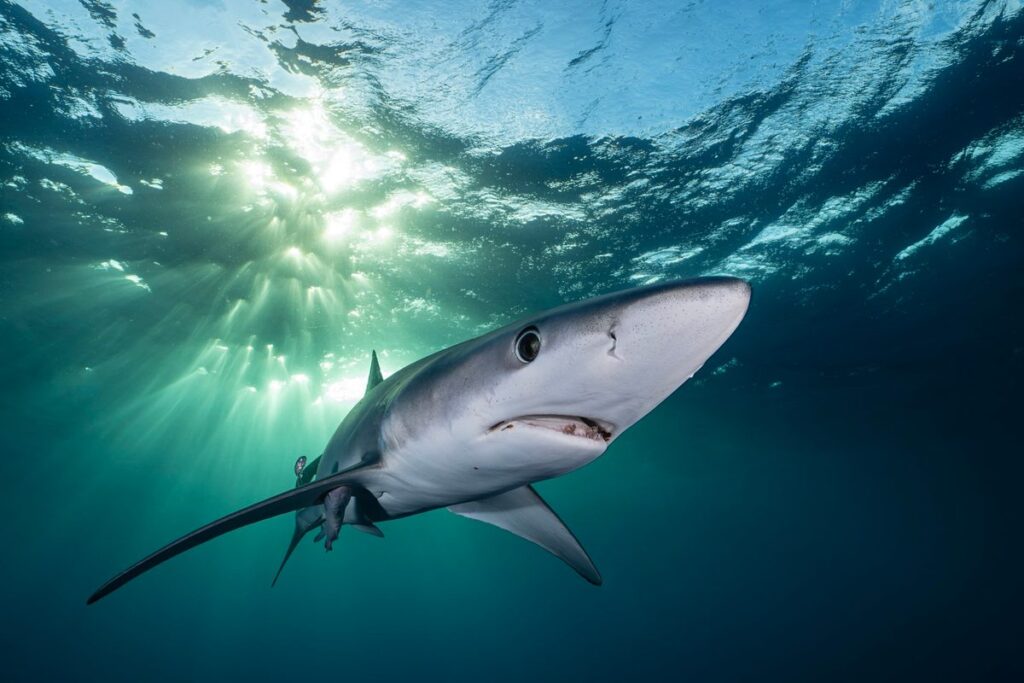
A Blue Shark swims just under the surface, offshore Baja California, while the sun begins to set in the late afternoon
The first time you encounter a blue shark in the ocean, its striking azure hue is unmistakable. However, recent research reveals that these marine creatures possess a unique ability to change their color, shifting from blue to shades of green and even gold. This discovery was unveiled at the Society for Experimental Biology Annual Conference, shedding light on the fascinating mechanisms behind their vivid coloration.
Blue sharks, known scientifically as Prionace glauca, owe their distinctive color to specialized crystals embedded within their scales. These crystals not only create their signature blue but also grant them chameleon-like abilities, according to the researchers.
How Blue Sharks Change Color
“Blue is one of the rarest colors in the animal kingdom,” explained Dr. Viktoriia Kamska from City University of Hong Kong. “Animals have developed a variety of unique strategies through evolution to produce it, making these processes especially fascinating.”
The blue shark employs a strategy involving special crystals within its dermal denticles—tiny, tooth-like scales covering its body. These denticles house guanine crystals, which reflect blue light, and melanin-filled sacs that absorb other wavelengths. “These components are packed into separate cells, reminiscent of bags filled with mirrors and bags with black absorbers, but kept in close association so they work together,” Kamska noted.
“When you combine these materials together, you also create a powerful ability to produce and change color,” said Professor Mason Dean.
To understand how these structures work, scientists used advanced technologies and computer simulations. By observing the interactions of light with these crystals, they discovered that when the crystals move closer together, the shark appears blue. Conversely, when they drift apart, the skin takes on green and gold hues.
Implications for Camouflage and Beyond
This color-changing ability could play a vital role in the shark’s survival, allowing it to camouflage in varying environmental conditions. Professor Dean explained, “In deeper, darker waters, the pressure might push the nanocrystals together more closely, turning the shark a darker blue, helping it blend in more seamlessly with its surroundings.”
The researchers are now eager to observe this phenomenon in the wild, studying how blue sharks adapt their color in natural habitats. Moreover, understanding this mechanism could inspire new ways to create non-toxic blue pigments for human use, reducing environmental pollution.
“A major benefit of structural coloration over chemical coloration is that it reduces the toxicity of materials and reduces environmental pollution,” Kamska added.
Comparisons with Other Marine Species
Blue sharks are not alone in their color-changing prowess. Cephalopods like octopuses, cuttlefish, and squid can alter their appearance rapidly, sometimes using these changes to communicate. Similarly, seahorses blend into their surroundings using chromatophores—tiny, pigment-filled pouches within their skin.
Studying the color mechanisms of blue sharks and other species, such as great whites, could offer new insights into evolutionary biology. “We know a lot about how other fishes make colors, but sharks and rays diverged from bony fishes hundreds of millions of years ago,” said Professor Dean. “This represents a completely different evolutionary path for making color.”
The research on blue sharks opens up exciting possibilities for both scientific understanding and practical applications, offering a glimpse into the intricate and often surprising world of marine life.






